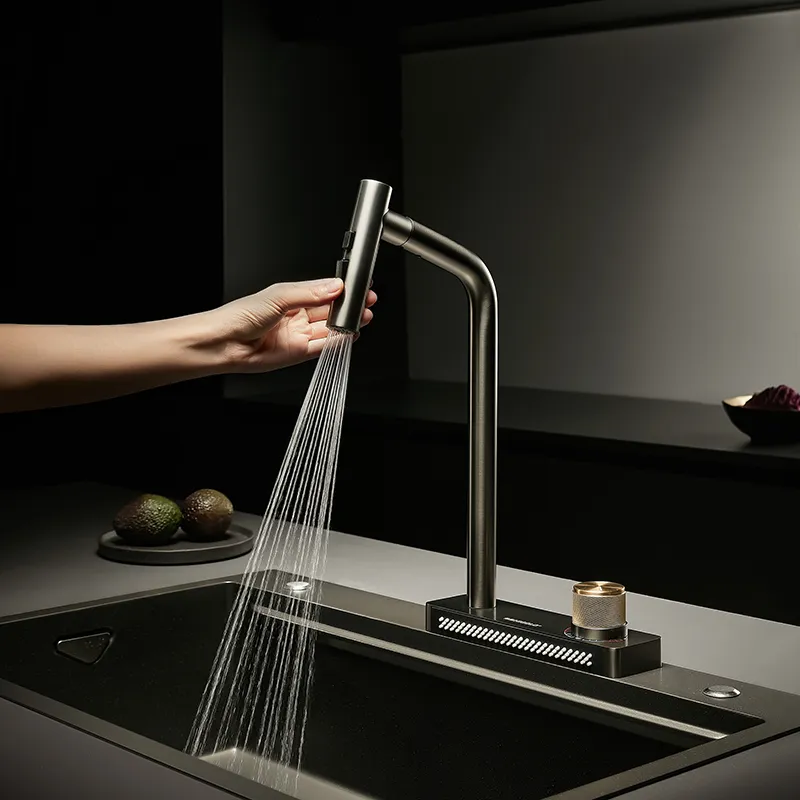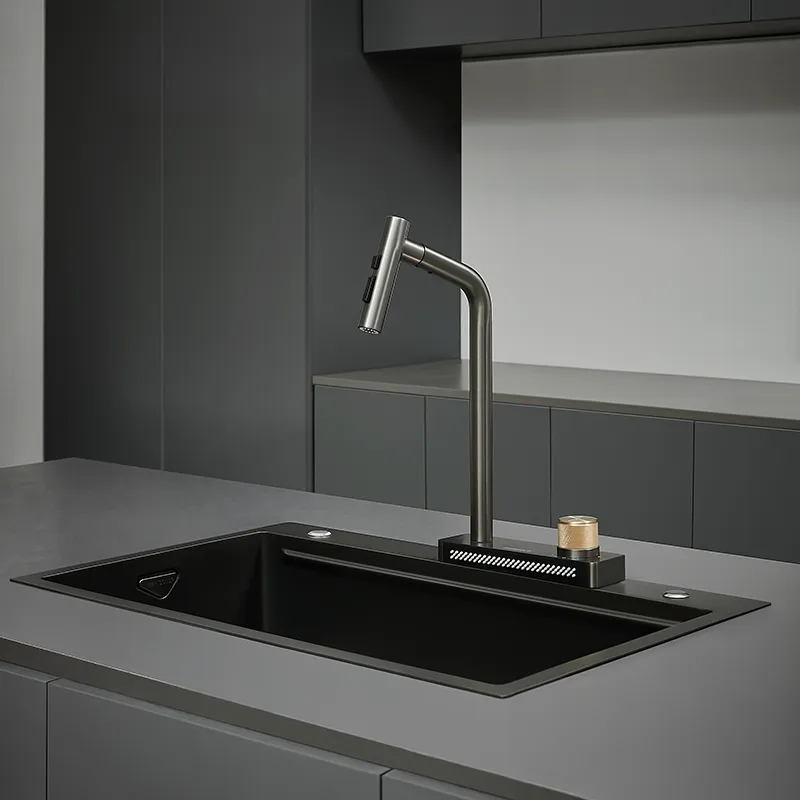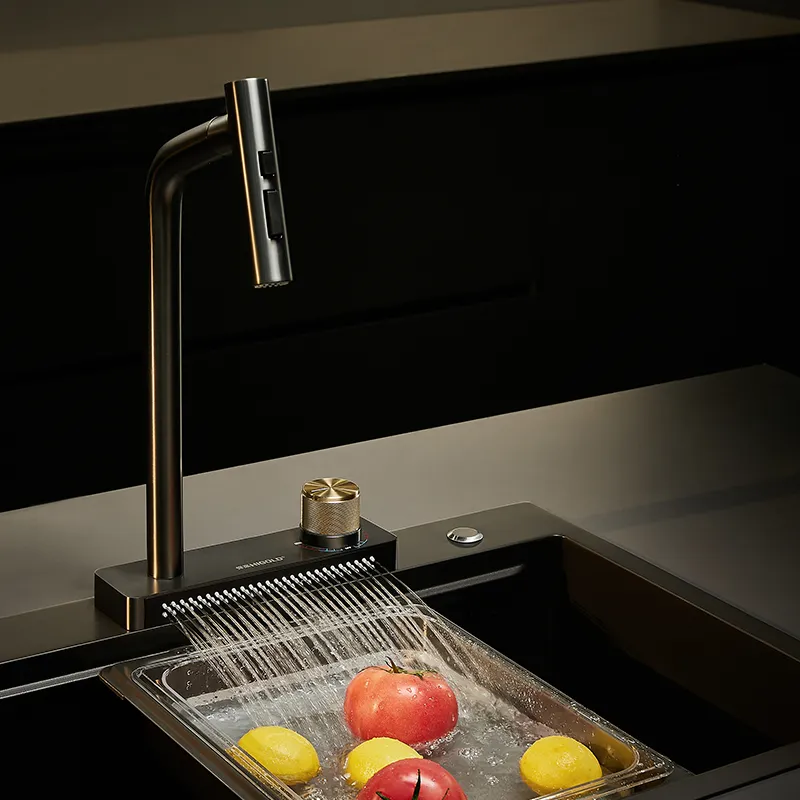Knowing the size of the sink hole is a crucial step when replacing or installing kitchen sink faucets. Choosing an inappropriately sized faucet can result in improper installation, leaks, or even failure to install the sink faucets, adding extra time and expense. Therefore, accurately measuring the size of the kitchen sink hole is the only way to ensure that the faucet you choose can be installed smoothly and used properly.
Although many people believe that the size of kitchen sink holes is a standardized specification, in fact, due to the wide variety of kitchen sinks and faucets, the size of sink holes varies greatly. Different brands and styles of faucets may have different installation requirements, and even different series of faucets of the same brand may not have exactly the same installation hole size. Therefore, knowing how to accurately measure the size of the sink hole is not only the key to a smooth installation, but also an important step to avoid faucet installation failures.
This article will explain in detail how to measure the size of kitchen sink faucets holes to help consumers choose the right faucet and avoid problems caused by mismatched hole sizes.

Why is it important to measure the size of the kitchen sink hole?
When installing sink faucets, the size of the sink hole is one of the basic conditions that determine whether the faucet can be installed smoothly. If the installation hole is too small or too large, the sink faucets cannot be installed and sealed properly, which may cause the following situations:
● Too small hole diameter: If the hole diameter of the sink is smaller than the diameter of the faucet base, the faucet will not be installed. Even if it is installed with a hard plug, it may cause the faucet to be unstable or leak.
● Too large hole diameter: If the hole diameter of the sink is larger than the base of the faucet, the faucet may be unstable and cannot be effectively fixed after installation. It is also easy to loosen during use and even leak.
● Mismatched installation: Even if the size of the sink hole is appropriate, the design of the sink may not match some faucets. For example, some faucets require a larger hole diameter to accommodate their more complex functional accessories (such as stretch water pipes, controls for multiple water flow modes, etc.). If you choose a mismatched sink faucets, it may not work properly.
● Sealing problem: When installing the faucet, it is necessary to ensure a good seal between the sink and the faucet base. If the hole diameter is too large or too small, it may not be effectively sealed, which will cause leakage problems.

How to measure the size of the kitchen sink faucets hole?
The main purpose of accurately measuring the size of the sink hole is to determine the hole diameter required for the sink faucets base. During the measurement process, in addition to the diameter of the hole, the depth and shape of the hole also need to be considered. The following will introduce the tools and steps required to measure the hole diameter one by one.
1. Prepare tools
Before measuring the size of the sink hole, you need to prepare some basic tools. Common measuring tools include:
● Caliper: Caliper is the best tool for accurately measuring hole diameter and hole depth. It can measure the diameter and depth of the sink hole very accurately.
● Tape measure: If the sink hole is large, use a tape measure to measure the width or depth of the hole.
● Level ruler: It can help determine whether the center of the hole is symmetrical with the sink position to ensure that the faucet will not tilt after installation.
● Pencil or marker: If you need to mark the size of the hole, a pencil or marker can be used to make marks.
2. Measure the hole diameter
The hole diameter is the most important measurement item because it determines whether the base of the sink faucets can be installed smoothly.
● Step 1: Use a caliper to measure the diameter of the sink hole. Place the two measuring ports of the caliper on both sides of the hole and gently clamp them, making sure that the measuring ports are completely in line with the edge of the hole.
● Step 2: Read the scale on the caliper and record the diameter of the sink hole. If the hole is irregular in shape, you can measure it in multiple places, making sure to record the maximum and minimum diameters.
● Step 3: If you don't have a caliper, a tape measure can also be used to measure the diameter of the hole. Place the tape measure on both sides of the hole, try to straighten it out, and record the diameter of the hole.
It is worth noting that the standard diameter of the kitchen sink hole is generally between 35 mm and 45 mm, and the specific size will vary depending on the design of the faucet. For example, some modern faucets (especially those with complex designs such as multiple water modes and stretch functions) may require a larger hole diameter. Therefore, when purchasing a faucet, be sure to check the installation requirements of the faucet to ensure that the size of the faucet base matches the sink hole diameter.
3. Measure the depth of the hole
In addition to measuring the diameter of the sink hole, you also need to know the depth of the hole. The depth of the hole affects whether the base of the sink faucets can be fully embedded in the hole and ensure that the faucet is firmly installed.
● Step 1: Use the depth measurement function of the caliper to measure the depth of the sink hole. Insert the depth rod of the caliper into the hole, gently push it to the bottom, and read the depth.
● Step 2: If the caliper does not have a depth measurement function, you can use a tape measure to measure the depth of the sink hole. Insert the tape measure vertically directly into the hole to check the depth of the hole.
● Step 3: After confirming the depth of the hole, you can check whether there are any obstacles in the sink, such as a support frame or specially designed parts inside the sink, which may limit the depth of the faucet base.
Generally speaking, the depth of the sink hole should be slightly larger than the base of the sink faucets to ensure that the faucet can be installed smoothly and stably fixed.
4. Check the location and shape of the hole
In addition to the diameter and depth, the location and shape of the hole are also factors to consider when installing the faucet. The sink hole may be round, oval or other irregular shapes. The specific hole shape will determine whether the faucet can fit the sink perfectly.
● Step 1: Check whether the sink hole is centered in the sink design. If the sink hole is not centered, it may affect the appearance of the faucet and even affect its use.
● Step 2: Measure the distance from the edge of the sink hole to ensure that the installation hole does not interfere with the rest of the sink. For sinks with multiple holes (such as hot and cold faucets and spout holes), you need to ensure that the spacing between the holes is sufficient to install multiple accessories.
5. Choose the right faucet
After measuring the size of the sink hole, the next step is to choose the right faucet based on the size of the hole. When purchasing a faucet, you should check the size requirements of the faucet base to ensure that it matches the measured hole diameter. In addition, you need to consider the type and installation method of sink faucets to ensure that it fits your kitchen design.
Common faucet base mounting hole sizes are generally 35mm to 40mm, which is suitable for most conventional kitchen sinks. However, some high-end faucets or specially designed faucets may require a larger hole diameter, so be sure to confirm the hole diameter requirements of the selected faucet when purchasing a faucet.

What are the common sink faucets hole diameter types?
To help consumers better understand the adaptation of sink holes of different sizes and faucet bases, the following are some descriptions of common sink hole diameter types and their adapted faucets.
● Standard single-hole faucet: This is the most common type of faucet, suitable for holes with a diameter of 35mm to 45mm. Most traditional sink faucets belong to this type.
● Two-hole faucets: If you choose a sink faucets with separate hot and cold water, you may need two holes, and the diameter of each hole is usually about 35mm.
● Multi-function faucets: Sink faucets with complex designs such as multiple water flow modes and stretched water pipes, which are common in modern kitchens, may require larger mounting holes, usually between 40mm and 50mm.
● Special design faucets: Some sink faucets have special designs and require customized hole diameters. In particular, some faucets with spray functions or with additional accessories may require larger hole diameters or even multiple holes during installation.

What Makes Higold's Kitchen Sinks Different from Other Brands?
Higold's kitchen sinks are crafted using advanced technology and high-quality materials like SUS304 stainless steel, ensuring long-lasting durability. We use laser cutting, robotic welding, and ultrasonic cleaning to ensure precision in every product. Our innovation and craftsmanship set us apart from other brands in the industry. As a leading supplier and manufacturer, we offer customized solutions and wholesale pricing to cater to various buyer needs, whether you're looking to buy in bulk or purchase exclusive designs.


